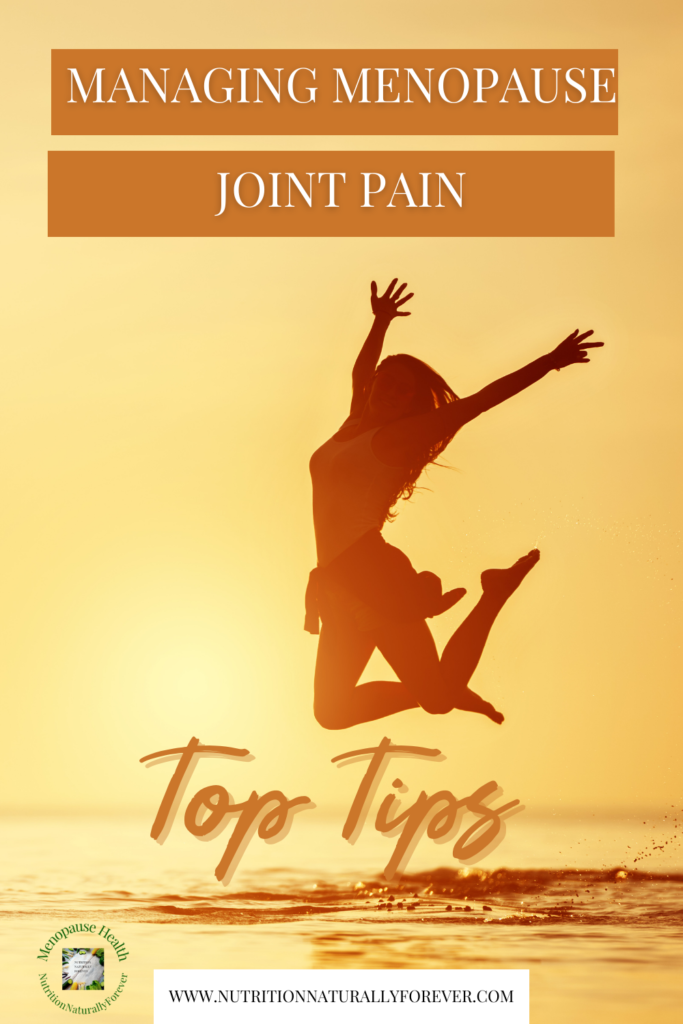
Top Tips for Managing Menopause Joint Pain
Joint pain was a symptom of menopause that I suffered from even before I knew I was peri-menopausal.
I have always been quite active either with structured exercise classes from aerobics and HiiT to yoga along with swimming and lots of walking.
I started to have issues with yoga when my shoulder gave me pain and then I would get up in the morning and hardly be able to walk down the stairs as my ankles were so stiff. I just put these issues down to injury and overuse.
It was only through my research as a nutrition therapist, before I started specialising in menopause health, that I thought, hang on a minute, could I be peri-menopausal?
The good news is that with understanding and knowledge, you can start putting strategies in place that will not only improve the aches and pains you may be experiencing today but these strategies will also support your future physical health.
The goal is to make your health span match your life span!
Here are my top tips;
Hydrate
This is the most boring but essential tip ha!
Drink. More. Water!
Optimal hydration helps to reduce inflammation by flushing out toxins.
Water also helps create synovial fluid.
Synovial fluid is a thin layer of fluid that cushions and delivers nutrition to your joints it also reduces friction when you move your joints.
Water is crucial for your cartilage, as about 65 – 80 per cent of cartilage is made of water so when you drink water, you not only help stimulate the production of synovial fluid but also help with cartilage regeneration and lubrication of the cartilage to reduce joint inflammation.
Get Enough Sleep
Easier said than done sometimes when you are a menopausal woman!
If you are also struggling with joint pain you may find it difficult to get to sleep, stay asleep or even find you end up getting up earlier than you want because of joint pain.
It’s a vicious cycle, so what can you do?
- Consider changing your sleeping position
- Look at other lifestyle reasons for poor sleep
- Is it time to change your mattress?
- Contact a medical professional for pain meds or sleeping aids to break the cycle
- Hydrate! Have I mentioned this?
Consider Supplementation
Could you be deficient in vitamin D?
Vitamin D supports the body to absorb calcium for healthy bones but a deficiency can show in symptoms such as;
- Fatigue
- Muscle & joint pain
- Neurological issues
- Low mood such as seasonal affective disorder (SAD)
I always recommend starting with food rather than manufactured supplements as these are more bio-available. For vitamin D add eggs, oily fish, meat and mushrooms that are grown outdoors to your diet.
Glucosamine is found in the fluid around our joints where it is vital for building cartilage and structural connective tissue. As we age, our bodies produce less glucosamine and supplementation is a popular choice for joint and cartilage support.
Glucosamine, chondroitin and MSM (methylsulfonylmethane) are known for their anti-inflammatory properties and ability to ease joint pain.
Another antiinflammatory growing in popularity in recent years is Turmeric.
Also known as Indian saffron, turmeric comes from the root of Curcuma Longa, a flowering plant that is native to both Asia and Central America. Curcumin is the active ingredient in turmeric and has long been used in Ayurvedic and traditional medicine due to its antibacterial, antimicrobial, anti-inflammatory, and antioxidant effects.
Add Turmeric to soups, curries or bolognese but don’t forget to add some ground black pepper, this enables our body to absorb the benefits.
Change the Temperature
Using a heat pack or hot water bottle will help to reduce joint stiffness and pain.
If you have swelling it is better to start with an ice pack for 20 minutes.
Alternating between cold and heat supports the lymphatic system as the heat relaxes and the cold contracts and helps the lymph fluid pump through the body encouraging the reduction of inflammation and promoting healing.
Exercise & Weight-loss
**Trigger Warning!
As an anti-diet nutrition therapist, you will never EVER hear me say “Move more and lose weight”, it is so much more complicated than this!
However, if you are currently living in a bigger body, this could be impacting your joint pain.
Inflammation will definitely be having an effect on the size of your body and exercising might only increase inflammation, so what can you do?
All my clients go through my signature SHIFT system.
The I stands for Inflammation.
Focusing on reducing inflammation in the body, through food and lifestyle strategies will reduce joint pain and naturally reduce excess fat the body is holding on to.
From there learning how to nourish your body rather than punish it during menopause you will be able to create a sustainable plan so that you can achieve your health and well-being goals and turn your dreams and desires into a reality.
Get started today
Download your free copy of my eBook ‘The Secrets Behind Nutrition for Menopause’.
Learn the top 5 nutrients you need to focus on to take control of your menopause journey naturally.
Book a complimentary 30-minute menopause assessment to get your questions answered and understand your unique menopause journey.
